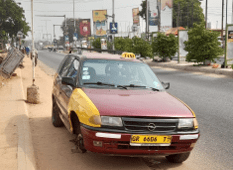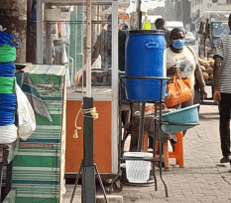By Ebenezer OWUSU-ANSAH
Walkways are an essential component of urban infrastructure, designed to ensure the safe movement of pedestrians.
However, in many parts of Accra, these vital pathways have been rendered virtually unusable due to widespread encroachment, negligence, and misuse. Walking in the central district of Accra has become an ordeal—one that only the physically fit dare to undertake.
The Deterioration of Walkways
Despite efforts by district assemblies to construct and maintain walkways, their condition across the city is alarming. These walkways, initially built to enhance both mobility and aesthetics, have been abused to the point of becoming hazardous.
A tour around the city reveals a grim reality: walkways blocked by illegally parked cars, food vendors, and even small-scale business operators, leaving pedestrians with no choice but to risk walking on busy roads.
One of the most concerning developments is the increasing use of walkways by motorbike riders as alternative routes to bypass traffic congestion. This reckless behavior puts pedestrians at grave risk, as walkways are not designed to accommodate speeding vehicles. The lack of sufficient public parking spaces has also led to motorists occupying these pedestrian pathways, forcing people onto the streets and leading to frequent hit-and-run incidents.
The Pedestrian Safety Crisis
Pedestrians remain the most vulnerable road users in Ghana. According to the Accra Road Safety Report 2023, pedestrian deaths accounted for a staggering 82% of road fatalities. Although pedestrian-related accidents have decreased over the years, they still constitute one of the highest causes of road injuries and deaths in urban areas.
The root causes of this crisis go beyond reckless driving. Walkways themselves have become death traps due to neglect and poor maintenance. Utility companies such as the Ghana Water Company, the Electricity Company of Ghana, and telecommunications providers frequently dig up pavements for maintenance work, leaving gaping holes behind. Even when attempts are made to repair these walkways, the shoddy patchwork leaves them uneven and hazardous.
The Role of Authorities in the Problem
Ironically, the very authorities responsible for infrastructure development have contributed to the encroachment on walkways. Permits are routinely granted for the erection of billboards and other structures directly on pedestrian paths. This official complicity exacerbates the crisis, creating an environment where individuals and businesses feel emboldened to misuse these public spaces.
Street vendors, including food sellers and vulcanizers, have also hijacked walkways. Cooking activities leave oil spills that make surfaces slippery and dangerous, while discarded waste turns walkways into unsightly dumping grounds. Some vendors have even gone as far as reconstructing portions of walkways with unauthorized materials to create makeshift market stalls. Pedestrians who dare to walk through these spaces often face verbal abuse or outright refusal of passage.
Why Functional Walkways Matter
Walkways are more than just paved paths; they serve as crucial infrastructure for safe, healthy, and sustainable urban living. A well-maintained pedestrian network offers numerous socio-economic and environmental benefits:
- Reduces Road Fatalities: A well-structured pedestrian system helps keep people off the streets, thereby reducing accidents and fatalities.
- Encourages Healthy Lifestyles: Walking is a simple and cost-effective way to stay physically active, reducing the prevalence of lifestyle-related diseases.
- Lowers Traffic Congestion and Pollution: Encouraging walking reduces dependence on cars, subsequently decreasing traffic congestion, air pollution, and greenhouse gas emissions.
- Enhances Community Livability: Safe and accessible walkways contribute to more connected and inclusive communities, particularly benefiting children, the elderly, and persons with disabilities.
A Call to Action

We cannot afford to continue ignoring the deterioration of our walkways. It is imperative that city authorities, urban planners, and law enforcement agencies take decisive steps to reclaim and restore these pathways to their intended purpose. Enforcing pedestrian rights, removing illegal structures, and investing in the proper maintenance of walkways should be prioritised.

It is time to rethink our urban infrastructure. As the famous urbanist Jane Jacobs once said,“Streets and their sidewalks—the main public places of a city—are its most vital organs.” By investing in safer and well-managed pedestrian walkways, we are making an investment in the future of our cities and the well-being of their inhabitants.
Let us all take a stand to protect our walkways—because a walkable city is a livable city.










